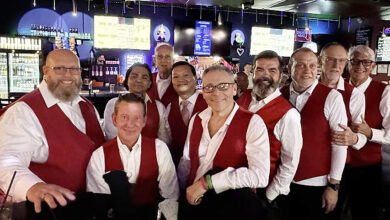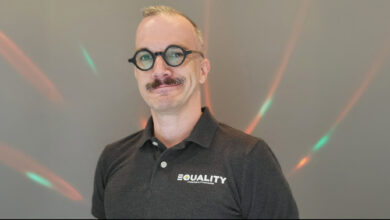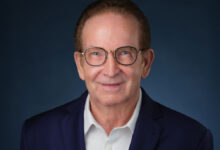
By Andrew Edmonson
As he nears his ninth decade, the great gay British artist David Hockney shows absolutely no signs of slowing down. He still works in his studio seven days a week.
In July, the Royal Academy of Arts in London will exhibit 82 portraits that he created in his Los Angeles studio over the last two years, despite having sustained a stroke in 2012.
From February 9 to May 29, 2017, Tate Britain will present a major retrospective of his work, which will then travel to the Centre Pompidou in Paris and The Met Breuer in New York.
And on July 8 and 10, 2016, the Museum of Fine Arts, Houston, will present the local premiere of the acclaimed documentary Hockney, chronicling the life of the working-class rebel with a shock of blonde hair who led the vanguard of British Pop Art movement in the early 1960s and went on to emerge as one of the most popular British artists of the second half of the 20th century. The film is directed by Brit Randall Wright, and it incorporates never-before-seen video and photos from Hockney’s personal archive.
“It has been observed that there is something of the holiday about David Hockney that, despite personal loss, he sees the world with holiday eyes, as if for the first time,” remarks Wright. “I wanted to capture this attitude without taking away the magic and mystery of a great artist.”

Born in 1937 into a loving working-class family in the industrial city of Bradford in northwestern England, Hockney always marched to the beat of his own drummer. “One of the things my father thought was not to worry too much what the neighbors think,” he recalls in the film. “I took that lesson.”
In 1959, he moved to London to study at the Royal College of Art, and began to quietly explore his sexual orientation in his work, most notably in the four “Love” paintings he created around 1960. He came out at age 23, seven years before homosexuality was decriminalized in staid, straight-laced Britain. “When you said you were gay in the 1960s, people said it was illegal,” he recalls. “Well, I said ‘I lived in Bohemia, and Bohemia is a tolerant place.’”
At this same time, his star in the art world was ascendant.
John Kasmin, the British art dealer who discovered Hockney at the age of 24, recalls, “He’d already become a blonde, a flamboyant dresser, a maker of public statements—the sort of person who draws the attention of journalists.
“It was the very moment when the eye of the press and the tastemakers was on the British art world and fashion world,” Kasmin continues. “And David stood out as one of the banner-carriers for the new approach to art, life, and, in fact, the emerging openness of gay life.”
In 1964, he travelled to California and fell in love, both with Los Angeles and a handsome UCLA student named Peter Schlesinger, with whom he would maintain a tumultuous relationship for the next decade.
“When I went to Los Angeles, it was really three times better than I thought it would be,” he recalls. “I had just read the American novel called City of Night by John Rechy, which has accounts of the kind of low life in American cities [that] I thought was wonderful and colorful. I wanted to get up to Hollywood to see what it was all like—to see the hustlers.”
The movie charts how Hockney, keenly curious and ever inventive, explored the world of opera as a prolific designer of décor, and how he embraced technology in his artistic practice, from photocopying, Polaroids, fax-machine images, to iPad drawings. His greatest hero and inspiration was Pablo Picasso, both for his longevity and his many phases as an artist.
Perhaps the most affecting section of the film deals with the staggering losses Hockney sustained during the AIDS crisis. “At the time I couldn’t write down all the people,” he observes quietly in the film. “You think about them every day, and then you stop it because there’s too many, actually. It would rather drive you mad if you think about it. Slowly it’s become part of your life, something you never, ever expected.”
Hockney has also influenced many artists, curators, and museum directors, among them Bill Arning, the director of the Contemporary Arts Museum, Houston, who completed his undergraduate senior art-history thesis on Hockney’s designs for the Metropolitan Opera’s version of Erik Satie’s Parade. “As someone who has always felt that the history of queer image-making needs to be available in a clear, concise form for tomorrow’s art students, just as the legacy of African-American artists is today, Hockney’s place in this tradition is paramount,” Arning observes.
“My other connection with Hockney had to do with my first experience of seeing the exhibition at the Museum of Fine Arts, Boston, of Hockney’s portraits over three decades,” Arning recalls. “The great double-portraits of the 1960s looked tremendous, like a contemporary Velásquez. But the work of the 1980s and 1990s is very painterly—quickly rendered, cartoony portraits that seemed altogether less interesting and slightly amateurish, not at all by the same artist.
“But for some reason, I returned to hear the artist’s public lecture,” Arning continues. “He explained that after that period when so many friends were dying, whenever someone in his inner circle passed away he felt a compulsion to draw those people he loved that were alive around him and record their faces as quickly as possible, as a way of saying to the heavens ‘We are still here.’ Given the collective grief of that period, I walked back through the show and found the same paintings intensely moving. Now when I encounter one on its own, I find them irresistible.”
As Hockney himself once observed, “New ways of seeing mean new ways of feeling. I do believe that painting can change the world.”
What: Hockney
When: July 8 and 10
Where: Museum of Fine Arts, Houston
Details: mfah.org/films
Andrew Edmonson serves on the advisory board of The Oral History Project, which is capturing the personal stories of the AIDS crisis in Houston, Harris County, and Southeast Texas.










